#Tchokwe
Explore tagged Tumblr posts
Text
United Nations Day [24 October]

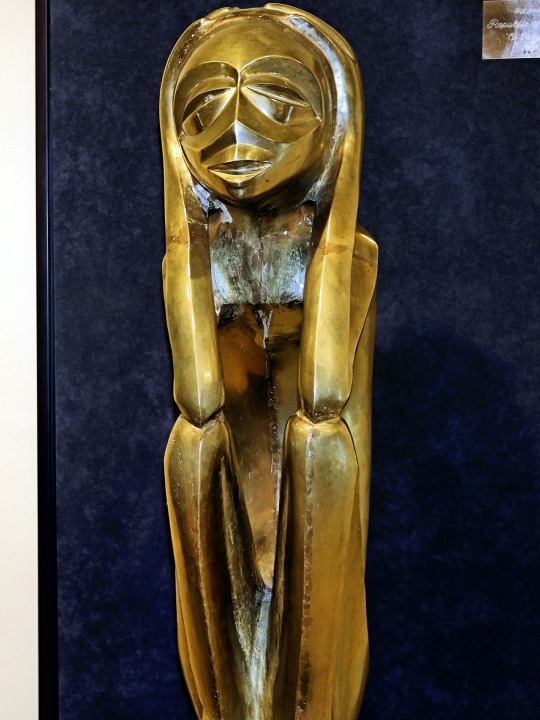
May Peace Prevail on Earth. ~ Masahisa Goi
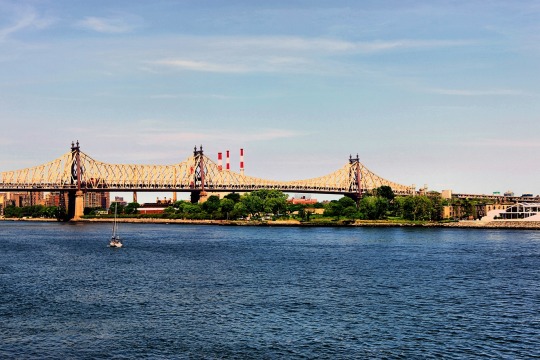
#United Nations#United Nations Day#Sculpture#O Pensador#Chokwe#Tchokwe#Statue#UN#Peace#Peacekeepers#UNDay#Turtle Bay#United Nations Secretariat Building#United Nations Headquarters#Queensboro Bridge#East River#Men of Peace#Manhattan#New York City#New York
6 notes
·
View notes
Text
Gallery Collection 001

Published: 2-21-2024 | Updated: N/A SUMMARY This is the first in a series of upcoming investment objects for Sims 2 – things your sims can use to generate income over time. From 1975-2000, Anheuser-Busch, Inc. commissioned 30 paintings of African kings and queens for an extended outreach and marketing campaign. This set of paintings features artwork from this amazing series. Celebrate Black History Month 2024! #co2bhm #bhm2024 #sims2bhm. *No copyright infringement intended – I own no rights to these images.
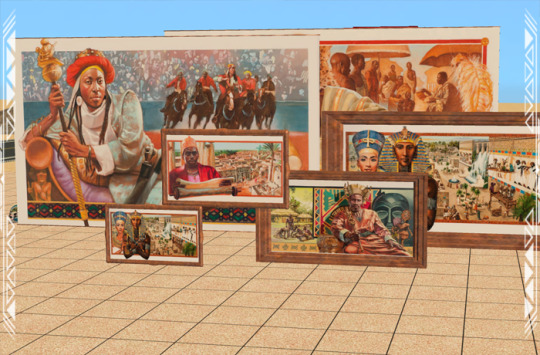
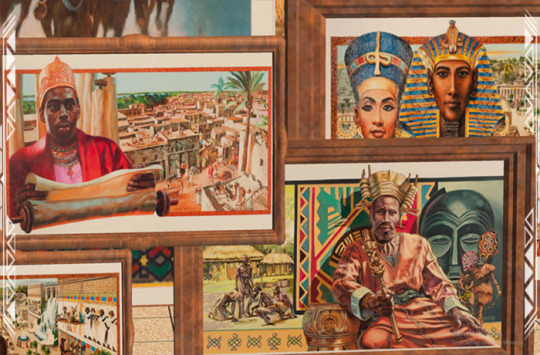
DETAILS Requires Sims 2. Requires Apartment Life for shiftability. §1K-15K | Buy > Deco > Wall Hangings Paintings are centered on 1-tile but cover more tiles than that. They come in various gallery sizes and images have been edited to fit the mesh. After purchase, their value increases by approximately 2% daily – watch out for burglars! Files with “MESH” in their name are REQUIRED. Frame recolors include EA/Maxis and yeti textures. Frame and painting recolors are merged into two files so you’ll have to take them or leave them. ITEMS Great Kings & Queens of Africa: Paintings 001-006 (92-764 poly) DOWNLOAD (choose one) from SFS | from MEGA
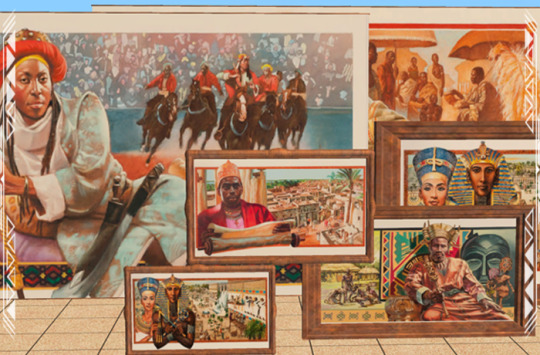
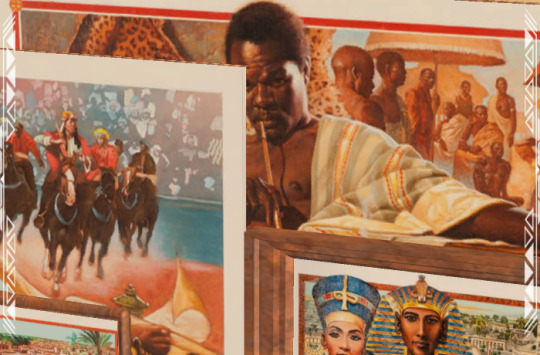
IMAGES
Akhenaton Pharaoh of Egypt (1375-1358 BC) by Barbara Higgins Bond
Alfonso I King of the Kongo (circa 1486-1543) by Carl Owens (1929-2002)
Askia Muhammaed Toure King of Songhay (1493-1529) by Leo Dillon
Benhanzin Hossu Bowelle—The King Shark (1841-1906) by Thomas Blackshear II
Cleopatra VII Queen of Egypt (69-30 BC) by Ann Marshall
Hannibal Ruler of Carthage (247-183 BC) by Charles Lilly
Hatshepsut The Ablest Queen of Far Antiquity (1503-1482 BC) by Dean Mitchell
Idris Alooma Sultan of Bornu (1580-1617) by Charles Lilly (1949-)
Ja Ja King of the Opobo (1821-1891) by Jonathan Knight
Khama III The Good King of Bechuanaland (1819-1923) by Carl Owens
Makeda Queen of Sheba (960 BC) by Debra Edgerton
Mansa Kankan Musa King of Mali (1306-1337) by Barbara Higgins Bond
Menelek II King of Kings of Abyssinia (1844-1913) by Dow Miller
Moshoeshoe King of Batsutoland (circa 1786-1870) by Jerry Pinkney
Mwana Ngana Ndumba Tembo—Ruler of the Angolan Tchokwe (1840-1880 circa) by Kenneth Calvert
Nandi Queen of Zululand (1778-1826 AD) by HM Rahsaan Fort II
Nefertari Nubian Queen of Egypt (192-1225 BC) by Steve Clay
Nehanda of Zimbabwe (1862-1898) by Lydia Thompson
Nzingha—Amazon Queen of Matambo (1582-1663) by Dorothy Carter
Osei Tutu King of Asante (circa 1650-1717) by Alfred Smith
Queen Amina of Zaria (1588-1589) by Floyd Cooper
Samory Toure The Black Napoleon of the Sudan (1830-1900) by Ezra Tucker
Shaka-King of the Zulus (1787-1828) by Paul Collins
Shamba Bolongongo African King of Peace (1600-1620) by Roy LaGrone
Sunni Ali Beer King of Songhay (circa 1442-1492) by Leo Dillon
Taharqa King of Nubia (710-664 BC) by John Thomas Biggers
Tenkamenin King of Ghana (1037-1075 AD) by Alexander Bostic
Thutmose III Pharaoh of Egypt (753-712 BC) by Antonio Wade
Tiye The Nubian Queen of Egypt (circa 1415-1340 BC) by Leonard Jenkins
Yaa Asantewa Queen of Ghana (1863-1923) by Barbara Higgins Bond CREDITS No copyright infringement intended – I own no rights to these images. Artwork and trademarks are the property of their respective creators and/or owners. If this exceeds fair use, please contact me via private message. Thanks: Simming and Sketchfab Communities. Sources: Any Color You Like (CuriousB, 2010), Beyno (Korn via BBFonts), Console Certificates (d_dgjdhh, 2019; 2011), EA/Maxis, Gyeongbokgung Sajeongjeon Painting (National Heritage Administration, 2024 via CCA; Sketchfab), Great Kings and Queens of Africa Series (Anheuser-Busch, Inc., 1975-2000; Kentake, 2016), Offuturistic Infographic (Freepik), Painting by Zdzislaw Beksinski (Sosnowski, 2018 via CCA), Yeti Metals (Shastakiss, 2017).
88 notes
·
View notes
Text










18) Angola (CD)
1. Front for the Liberation of the Enclave of Cabinda [Front Wyzwolenia Enklawy Kabindy] (ok. 1975–obecnie) [1]
2. Front for the Liberation of the Enclave of Cabinda [Front Wyzwolenia Enklawy Kabindy] (ok. 1975–obecnie) [2]
3. Front for the Liberation of the Enclave of Cabinda [Front Wyzwolenia Enklawy Kabindy] (ok. 1975–obecnie) [3]
4. Front for the Liberation of the Enclave of Cabinda-Renovada [Front Wyzwolenia Enklawy Kabinda-Renovada (lata 90. XX wieku – obecnie)
5. Liberation Front of the State of Cabinda [Front Wyzwolenia Państwa Kabinda]. Poziomy trójkolorowy symbol w kolorze niebieskim, miedzianym i czarnym, na środku znajduje się padrão upamiętniające Traktat Simulambuco (1996���obecnie)
6. Cabinda Free State [Wolne Państwo Kabinda]. Poziomy trójkolorowy wzór w odcieniach miedzi, bieli i czerni (?-obecnie)
7. Flaga ludu Lunda-Tchokwe
8. Flaga ludu Kongo
9. Flaga Królestwa Mbunda. Biała flaga z rysunkiem słonia afrykańskiego [1]
10. Flaga Królestwa Mbunda. Biała flaga z rysunkiem słonia afrykańskiego [2]
0 notes
Photo

Male face mask (chihongo) of the Chokwe people, Angola or Democratic Republic of the Congo. Artist unknown; 2nd half of 19th century. Now in the Art Institute of Chicago. Photo credit: Art Institute of Chicago.
#art#art history#Africa#African#African art#Central Africa#Central African art#indigenous peoples#indigenous art#folk art#Chokwe#Tchokwe#African religions#mask#headdress#woodwork#carving#19th century art#Art Institute of Chicago
83 notes
·
View notes
Photo

History Luba origin has two school of thoughts, one from historical and archaeological points of view and the other from oral traditions of Luba people. Historically, the larger Luba people of Africa including Democratic Republic of Congo and Zambia (Lunda and Tchokwe people) were part of Bantu people that migrated out of West Africa in the Great Bantu migration. They are regarded as one of the earliest peoples to practice Ironworking in Central Africa. Their ancestors were farmers who, as early as 400 CE, inhabited the Lake Kisale region of Katanga.
According to the oral traditions of the Baluba, the genesis of the tradition of the kingdom, an aristocratic hunter hero coming from the East (Mbidi Kiluwe) met an aboriginal ruler (Nkongolo); unaware of the demanding customs of sacred kingship, notably of the meal rituals, he married the two sisters of this ruler and went back alone to his country. One of the sisters gave birth to a son (Kalala Ilunga) who eventually became a mighty warrior whom the ruler planned to kill. The young man had to flee to his father's country. Later, he came back, beheaded his maternal uncle, and became the first king of the Luba. These traditions gave rise to a controversy between, on the one hand, structuralists, who argue that the epic is representative of mythic ground shared by many Bantu-speaking peoples, and on the other hand, Africanist historians, who consider either that the epic contains traces of ancient historical facts or that it is a political charter legitimizing the prerogatives of the dynasty. However that may be, the Luba Kingdom was founded in the eighteenth century or before, in the vicinity of the present town of Kabongo. It exerted a strong political influence on its neighbors and was the main reference point for many rulers' genealogies and many religious institutions of the Eastern Savanna peoples.
Around 1500, possibly earlier, the Luba began to coalesce into a single, unified state, under the leadership of kings ruling by divine sanction. The mulopwe, or king, was drawn from the balopwe, a group who acted as intermediaries between the world of mankind and the world of spirits and ancestors. The mulopwe had three sources of power: *He headed a secular hierarchy of governors and under-governors, running down to local village headmen. *He collected tribute from local chiefs, which was then redistributed in the form of gifts to loyal followers. In practice this tribute system amounted to a network of state controlled trade.
*The mulopwe commanded significant spiritual prestige. He was the head of the Bambudye (or Mbudye) secret society, to which all kings, chiefs and officials belonged. The Bambudye society, which included both men and women, transcended kinship lines and helped knit the realm together. Bambudye “Men of Memory” preserved the tribes oral tradition
57 notes
·
View notes
Text
Arte Sona candidata a Património Mundial
Arte Sona candidata a Património Mundial
Arte Sona candidata a Património Mundial. O Ministério da Cultura e Turismo (MCT) está a preparar a apresentação da candidatura da arte etnomatemática “Sona”, símbolo da cultura tchokwe, a Património Mundial da Humanidade da UNIESCO, soube hoje, sexta-feira, a ANGOP. A informação foi prestada pelo director do gabinete provincial da Cultura, Turismo, Juventude e Desportos na Lunda Norte, Josefo…

View On WordPress
0 notes
Photo

Máscara Tchokwe
Angola
in: Bestnet
55 notes
·
View notes
Photo

"#Sona é um conjunto de símbolos de origem #tchokwe, povo que habita o nordeste de #Angola e as regiões próximas da República do #Congo e #Zâmbia." Li isso em #Cumbe, obra de @marcelo.dsalete. Essa singela introdução à #iconografia da arte e cultura tchokwe foi uma das coisas que mais me chamou a atenção no livro, sem falar - é claro - na beleza que é, por si só, a ideia de um ideograma proverbial. (em Jardim Palmares - Paciência) https://www.instagram.com/p/CA89ssWFDJg/?igshid=1xm4fads721zd
1 note
·
View note
Video
youtube
2 notes
·
View notes
Text
100 anos - DIAMANG, 2017
100 anos – DIAMANG, 2017
Bom Agosto, boas férias para todos os que as gozam agora. É altura de começar a planear o final do ano e 2018. A DIAMANG faz 100 anos daqui poucos meses. É oportunidade para celebrarmos ao longo de 2017 e 2018, a DIAMANG e os diamantes, Portugal e os Portugueses, Angola e os Angolanos. Já existem algumas ideias; são precisas mais. O que podemos fazer, e onde?
O quê?
Conferências…
View On WordPress
#100 anos#1917#2017#Angola#Angolanos#DIAMANG#diamantes#diamonds#Lunda#Portugal#Portugueses#Quiocos#Tchokwe#um século
0 notes
Text
The Chihongo and Pwo Masks are the best known of the tchokwe and the most appreciated in museums and private collections around the world . Pwo used to represent a mature woman who was able to prove her fertility by having a child. More recently, however, this mask has come to represent, possibly due to European influence, a young girl and the desire to have many children. . The Pwo mask has multiple facets: it can represent a female figure in general, with its caricature features, or secretly be the portrait of someone important and loved. . Its versatile character is also noticeable due to its use in very popular performance shows, which can take place on different occasions, from ceremonies considered traditional by the Tchokwe and, currently, even at political rallies and parties such as Christmas. . image: Masked Mwana Pwo - Henrique Augusto Dias de Carvalho Portuguese Expedition to Muatiânvua 1884-1888: O Jornal As Colônias Portuguesas, 1893. Vol. 3
#edisonmariotti @edisonblog
.br
As máscaras Chihongo e Pwo são as mais conhecidas dos tchokwe e as mais apreciadas nos museus e coleções privadas ao redor do mundo . Pwo costumava representar uma mulher madura que conseguiu provar a sua fertilidade ao ter uma criança . Mais recentemente, no entanto, essa máscara passou a representar, possivelmente por influência europeia, uma moça jovem e o desejo de ter muitos filhos . A máscara Pwo apresenta múltiplas facetas: pode representar uma figura feminina em geral, com seus traços caricaturais, ou secretamente ser o retrato de alguém importante e amado. . O seu caráter versátil também é perceptível devido ao seu uso em espetáculos performáticos bastante populares, que podem acontecer em diferentes ocasiões, desde cerimônias tidas como tradicionais dos tchokwe e, atualmente, até em comícios políticos e festas como a de Natal. . imagem: Mascarado Mwana Pwo - Henrique Augusto Dias de Carvalho Expedição Portuguesa ao Muatiânvua 1884-1888: O Jornal As Colônias Portuguesas, 1893. Vol. 3

0 notes
Link
Résultats de la recherches des termes “Tchokwe Sona” sur JStor.org
> Résultats intéressant
0 notes
Photo

#NdumboTembo maintained the Tchokwe sovereignty and protected its resources by securing an autonomous territory that severely restricted European access. Ndumba Tembo’s work allowed the Tchokwe to retain their independence. #budweiserlegendsofthecrown #blackhistory BEST STORY BASED IN BROWNSVILLE/ENY!!! 📕Natural Gee: Battle Tested/Natural Gee 2: New Era📕 LIMITED EDITION DOUBLE FEATURE!!! AVAILABLE FOR ONLY $11.99!!! Walk with @author_kasim_stevens thru these streets and see the path of some real life Gees tru through my eyes. Welcome to my world. Swing by @Amazon and grabbin a copy of this one of a kind item from @kriminalkontentpublishing… @mclyte @mcmilkdee @erykahbadu @angelayee @therealaplus @therealgrandwizzardtheodore @jaydacheaves @whiteboyrickmovie @joebudden @thebsimone @blacchyna @charliexxile @champagnepapi @therealgrandmastercaz @charliechaseofficialpage @cubanlinkclk @og_killer_kev @davinchi @djpremier @daveeast @therealeve @eminem @shameekspeight @therealfaithevans @floydmayweather @southwest263 @richforever @popsbarandgrill @loriharvey @kyrieirving @hitmansteviej_1 @nipseyhussle @alwissaminc @j @jimjonescapo @john_forte @michaelbjordan @kyliejenner @keyshiacole @lilbaby @mrdjcoolv @iamcardib @iamjasmineguy @iam_case1 @iamstephaniemills @majahhype @imroxanneshante @im.angelabassett #NaturalGee #BattleTested #NaturalGee2 #NewEra #DoubleFeature #Brownsville #EastNewYork #Brooklyn #noshavenovember #urbannovel #RichmondVA #dababy #sidechick #JacksonWard #KasimStevens #🔥📕 #litlitlit #blackauthor #screenplay (at Brooklyn Brownsville) https://www.instagram.com/p/CZcEYfGrwpy/?utm_medium=tumblr
#ndumbotembo#budweiserlegendsofthecrown#blackhistory#naturalgee#battletested#naturalgee2#newera#doublefeature#brownsville#eastnewyork#brooklyn#noshavenovember#urbannovel#richmondva#dababy#sidechick#jacksonward#kasimstevens#🔥📕#litlitlit#blackauthor#screenplay
0 notes
Photo

Tchokwe comb, mid 1900s, Congo.
21 notes
·
View notes
Link
Sona el por qué de los dibujos tchokwe Cap.I #Dibujostshokwe #DiagramasSona #Sona #huesodeIshango
0 notes